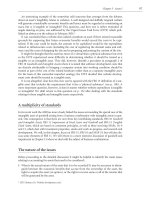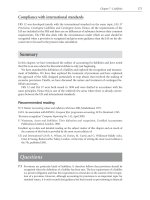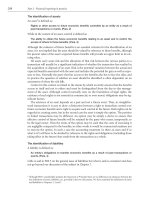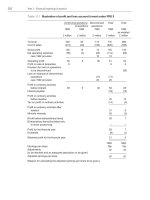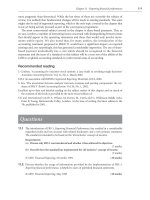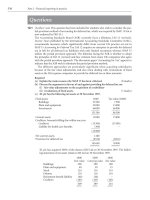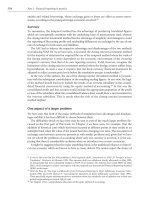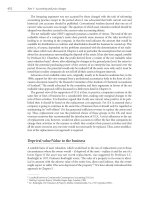Advanced financial accounting reporting ICWAI
Bạn đang xem bản rút gọn của tài liệu. Xem và tải ngay bản đầy đủ của tài liệu tại đây (2 MB, 21,000,962 trang )
FINAL
GROUP - IV
PAPER - 16
ADVANCED
FINANCIAL
ACCOUNTING
& REPORTING
The Institute of Cost and Works Accountants of India
12, SUDDER STREET, KOLKATA - 700 016
First Edition : January 2008
Revised Edition : March 2009
Second Revised Edition : June 2010
Reprint : May 2011
Published by:
Directorate of Studies
The Institute of Cost and Works Accountants of India
12, SUDDER STREET, KOLKATA - 700 016
Printed at :
India Limited,
50/2, TTC MIDC Industrial Area, Mahape, Navi Mumbai - 400 710, India
Copyright of these Study Notes is reserved by the Institute of Cost and Works Accountants
of India and prior permission from the Institute is necessary for reproduction of the whole
or any part thereof.
CONTENTS
Page No.
Study Note - 1
Introduction to IAS, USGAAP, Indian Accounting Standard ............................................................
1.1
Framework of Accounting ...............................................................................................................
1.1.1 Introduction ............................................................................................................................
1.1.2 Meaning of Accounting .........................................................................................................
1.1.3 Objectives and Functions of Accounting ............................................................................
1.1.4 Fundamental Accounting Assumptions .............................................................................
1.1.5 Limitations of Accounting ....................................................................................................
1.1.6 Financial Statements ..............................................................................................................
1.1.7 Qualitative Characteristics of Financial Statements ..........................................................
1.2
Accounting Standards - Applicability, Interpretation, Scope and Compliance ...............
1.3
1.4
1.5
1.6
1
2
2
2
3
3
4
4
5
US GAAPS ..........................................................................................................................................
1.3.1 Established Accounting Principles in the US .....................................................................
1.3.2 Other Accounting Literature ................................................................................................
1.3.3 AICPA ......................................................................................................................................
1.3.4 FASB .........................................................................................................................................
1.3.5 Components of US GAAP.....................................................................................................
International Accounting Standards ..............................................................................................
1.4.1 Introduction ............................................................................................................................
1.4.2 Extract of the International Accounting Standards ...........................................................
7
10
10
11
11
11
11
13
13
13
International Financial Reporting Standards ................................................................................
A Comparison IGAAP - US GAAP - IFRS .....................................................................................
29
39
Study Note - 2
Preparation of Company Accounts under Various Circumstances ....................................................
49
2.1
Merger and Acquisitions ..................................................................................................................
50
2.1.1 Introduction ............................................................................................................................
50
2.1.2 What is Merger? .....................................................................................................................
50
2.1.3 Varieties of Mergers ...............................................................................................................
51
2.1.4 Acquisitions.............................................................................................................................
51
2.1.5 Types of Acquisitions ............................................................................................................
52
2.1.6 Distinction Between Mergers and Acquisitions ................................................................
52
Accounting for Mergers and Acquisitions.....................................................................................
54
2.2.1 Methods of Accounting .........................................................................................................
55
Pooling of Interest Method ..................................................................................................
55
Purchase Method....................................................................................................................
56
2.2.2 How to Value an Acquisition ...............................................................................................
60
2.2
Page No.
2.3
2.2.3 Sources of Gains from Acquisitions ....................................................................................
60
2.2.4 Valuation Procedures ............................................................................................................
61
External Reconstruction....................................................................................................................
62
Illustrations........................................................................................................................................
I
Computation and Discharge of Purchase Consideration .................................................
II
Basics of Amalgamation and Absorption ...........................................................................
III
Purchasing Company holding shares in Selling Company .............................................
IV
Selling Company holding shares in Purchasing Company .............................................
V
Cross Holding .........................................................................................................................
66
66
73
118
142
146
VI
VII
VIII
IX
X
XI
XII
XIII
Chain Holding ........................................................................................................................
Internal Reconstruction .........................................................................................................
Reverse Merger .......................................................................................................................
External Reconstruction ........................................................................................................
Surrender of Shares ................................................................................................................
Demerger .................................................................................................................................
Sales of Division .....................................................................................................................
Impact of Reconstruction over Wealth of Investor and Company .................................
155
158
171
176
179
182
205
208
XIV
Buy back of Shares .................................................................................................................
211
XV
Conversion ..............................................................................................................................
217
Study Note - 3
Group Financial Statements ......................................................................................................................
225
3.1
Holding Company.............................................................................................................................
226
3.2
Methods of Combination ................................................................................................................
226
3.3
Accounting Treatment ......................................................................................................................
227
3.4
Preparation of Group Cash Flow Statement .................................................................................
299
3.5
Statement of Cash Flows ..................................................................................................................
300
3.6
Illustrations on Cash Flow Statement.............................................................................................
304
Study Note - 4
Segmental Reporting ...................................................................................................................................
359
4.1
Introduction........................................................................................................................................
360
4.2
Need for Segmental Reporting ........................................................................................................
360
4.3
Arguments against Segmental Reporting ......................................................................................
361
4.4
International Scenario .......................................................................................................................
362
Page No.
4.5
The Indian Scenario...........................................................................................................................
370
4.5.1 Definitions ...............................................................................................................................
370
4.5.2 Disclosure Requirements ......................................................................................................
373
4.5.3 Accounting and Auditing Issues .........................................................................................
373
4.6
Segmental Reporting Problems & Difficulties ..............................................................................
375
4.7
Specific Issues Relating to Management Accountants .................................................................
377
4.8
Segmental Disclosure – A Practical Example ................................................................................
381
4.9
Illustrations on Segmental Reporting .............................................................................................
385
Study Note - 5
Development in External Reporting ........................................................................................................
389
5.1
Indian Accounting Standards ..........................................................................................................
390
5.1.1 Companies (Accounting Standards) Rules, 2006...............................................................
390
5.1.2 Applicability of Accounting Standard to Non-corporate Entities ..................................
392
5.2
Accounting Standards ......................................................................................................................
395
5.3
Financial Reporting across the world .............................................................................................
473
5.4
Post Balance Sheet Events ................................................................................................................
477
5.5
External Reporting under Capital Market Regulations ...............................................................
479
5.6
Value Added Statement ...................................................................................................................
494
5.7
Economic Value Added Statement .................................................................................................
507
5.8
Human Resource Accounting..........................................................................................................
512
5.9
Environmental Accounting ..............................................................................................................
512
5.10
Guidance Notes on Accounting for Tax Matters ..........................................................................
516
5.11
Guidance Notes on Derivatives.......................................................................................................
533
5.12
Guidance Notes for Special Businesses / Reports ........................................................................
556
Study Note - 6
Government Accounting in India .............................................................................................................
571
6.1
6.2
6.3
6.4
Government Accounting in India ...................................................................................................
General Principles of Government Accounting ............................................................................
Methods of Government Accounting .............................................................................................
Comparison with Commercial Accounting...................................................................................
572
572
573
573
6.5
Comptroller and Auditor General of India ...................................................................................
574
6.6
Audit of Government Companies (Commercial Audit) ..............................................................
574
6.7
Audit Board Setup in Commercial Audit ......................................................................................
574
Page No.
Section - 11 Comptroller and Auditor General to Prepare and Submit Accounts to the
President, Governors of State and Administrators of Union Territories having
Legislative Assemblies......................................................................................................................
576
6.8
Public Accounts Committee.............................................................................................................
576
6.9
Role of Public Accounts Committee ...............................................................................................
581
6.10
Committee on Public Undertakings ...............................................................................................
582
6.11
Specimen Report ................................................................................................................................
583
STUDY NOTE - 1
Introduction to
IAS, USGAAP,
Indian
Accounting
Standard
This Study Note includes:
•
Framework of Accounting
•
Indian Accounting Standard
•
US GAAP
•
International Accounting Standards
•
International Financial Reporting Standards
•
Comparative Analysis of the Indian Accounting
Standard, IFRS and USGAAP
Framework of Accounting
1.1
Framework of Accounting
1.1.1 Introduction
Most of the world’s work is done through organizations - g roups of people who work together to
accomplish one or more objectives. In doing its work, an organization uses resources - l abor, materials,
various services, buildings, and equipment. These resources need to be financed, or paid for. To work
effectively, the people in an organization need information about the amounts of these resources, the
mean of financing them and the results achieved through using them. Parties outside the organization
need similar information to make judgments about the organization. Accounting is a system that provides
such information.
Organizations can be classified broadly as either for-profit or nonprofit. As these names suggest, a
dominant purpose of organizations in the former category is to earn a profit, whereas organizations in
the latter category have other objectives, such as governing, providing social services, and providing
education. Accounting is basically similar in both types of organizations.
1.1.2 Meaning of Accounting
The Committee on Terminology set up by the American Institute of Certified Public Accountants
formulated the following definition of accounting in 1961:
“Accounting is the art of recording, classifying, and summarizing in a significant manner and in terms of
money, transactions and events which are, in part at least, of a financial character, and interpreting the
result thereof.
As per this definition, accounting is simply an art of record keeping. The process of accounting starts
by first identifying the events and transactions which are of financial character and then be recorded
in the books of account. This recording is done in Journal or subsidiary books, also known as primary
books. Every good record keeping system includes suitable classification of transactions and events as
well as their summarization for ready reference. After the transaction and events are recorded, they are
transferred to secondary books. i.e. Ledger. In ledger transactions and events are classified in terms of
income, expense, assets and liabilities according to their characteristics and summarized in profit & loss
account and balance sheet. Essentially the transactions and events are to be measured in terms of money.
Measurement in terms of money means measuring at the ruling currency of a country, for example, rupee
in India, dollar in the U.S.A. and like. The transactions and events must have at least in par, financial
characteristics. The inauguration of a new branch of a bank is an event without having financial character,
while the business disposed of by the branch is an event having financial character. Accounting also
interprets the recorded, classified and summarized transactions and events.
1.1.3 Objectives and Functions of Accounting
The main objectives are Systematic recording of transactions, Ascertainment of results of recorded
transactions and the financial position of the business, providing information to the users for rational
decision-making and to know the solvency position. The functions of accounting are Measurement,
Forecasting, Decision-making, Comparison & Evaluation, Control, Government Regulation and Taxation.
2
Advanced Financial Accounting & Reporting
Accounting concepts
Accounting concepts define the assumptions on the basis of which financial statements of a business
entity are prepared. Certain concepts are perceived, assumed and accepted in accounting to provide
a unifying structure and internal logic to accounting process. The word concept means idea or notion,
which has universal application. Financial transactions are interpreted in the light of the concepts, which
govern accounting methods. Concepts are those basic assumptions and conditions, which form the basis
upon which the accountancy has been laid. Unlike physical science, accounting concepts are only result
of broad consensus. These accounting concepts lay the foundation on the basis of which the accounting
principles are formulated.
Accounting principles
“Accounting principles are a body of doctrines commonly associated with the theory and procedures of
accounting serving as an explanation of current practices and as a guide for selection of conventions or
procedures where alternatives exists.”
Accounting principles must satisfy the following conditions:
1.
They should be based on real assumptions;
2.
They must be simple, understandable and explanatory;
3.
They must be followed consistently;
4.
They should be able to reflect future predictions;
5.
They should be informational for the users.
Accounting conventions
Accounting conventions emerge of accounting practices, commonly known as accounting, principles,
adopted by various organizations above a period of time. These conventions are derived by usage and
practice. The accountancy bodies of the world may change any of the convention to improve the quality
of accounting information. Accounting conventions need not have universal application.
1.1.4 Fundamental Accounting Assumptions
The Financial Statements are prepared with the following three Fundamental Accounting Assumptions.
Unless otherwise specified the readers of the Financial Statements assume that the Financial Statements
are prepared in line with these assumptions. They are Going Concern, Consistency & Accrual. Accounting
Standard 1 describes them as follows
Going Concern: The enterprise is normally viewed as a going concern, that is, as continuing in operation
for the foreseeable future. It is assumed that the enterprise has neither the intention nor the necessity of
liquidation or of curtailing materially the scale of the operations.
Consistency It is assumed that accounting policies are consistent from one period to another.
Accrual Revenues and costs are accrued, that is, recognised as they are earned or incurred (and not as
money is received or paid) and recorded in the financial statements of the periods to which they relate.
(The considerations affecting the process of matching costs with revenues under the accrual assumption
are not dealt with in this Statement.)
3
Framework of Accounting
1.1.5 Limitations of Accounting
The Financials Statements are prepared on the basis of the above-mentioned assumptions, conventions
and the Accounting Principles which the accountant chooses to adopt. These bring in lot of subjectivity
to the Financial Statements and hence these basis assumptions conventions and principles become the
limitation of accounting.
The Financial Statements as the name states, accounts only for the items that can be measured by Money.
There are lots of items that money cannot measure but still are the most valuable assets for the enterprise,
like Human Resources, which the Financial Statements does not depict.
The language of accounting has certain practical limitations and, therefore, the financial statements should
be interpreted carefully keeping in mind all various factors influencing the true picture.
1.1.6 Financial Statements
Financial statements form part of the process of financial reporting. A complete set of financial statements
normally includes a balance sheet, a statement of profit and loss (also known as ‘income statement’), a
cash flow statement and those notes and other statements and explanatory material that are an integral
part of the financial statements. They may also include supplementary schedules and information based
on or derived from, and expected to be read with, such statements. Such schedules and supplementary
information may deal, for example, with financial information about business and geographical segments,
and disclosures about the effects of changing prices. Financial statements do not, however, include such
items as reports by directors, statements by the chairman, discussion and analysis by management and
similar items that may be included in a financial or annual report.
Users and Their Information Needs
The users of financial statements include present and potential investors, employees, lenders,
suppliers and other trade creditors, customers, governments and their agencies and the public. They
use financial statements in order to satisfy some of their information needs. These needs include the
following:
(a)
Investors. The providers of risk capital are concerned with the risk inherent in, and return provided by,
their investments. They need information to help them determine whether they should buy, hold or
sell. They are also interested in information which enables them to assess the ability of the enterprise
to pay dividends.
(b)
Employees. Employees and their representative groups are interested in information about the stability
and profitability of their employers. They are also interested in information which enables them
to assess the ability of the enterprise to provide remuneration, retirement benefits and employment
opportunities.
(c)
Lenders. Lenders are interested in information which enables them to determine whether their loans,
and the interest attaching to them, will be paid when due.
(d) Suppliers and other trade creditors. Suppliers and other creditors are interested in information which
enables them to determine whether amounts owing to them will be paid when due. Trade creditors
are likely to be interested in an enterprise over a shorter period than lenders unless they are dependent
upon the continuance of the enterprise as a major customer.
4
Advanced Financial Accounting & Reporting
(e)
Customers. Customers have an interest in information about the continuance of an enterprise, especially
when they have a long-term involvement with, or are dependent on, the enterprise.
(f)
Governments and their agencies. Governments and their agencies are interested in the allocation of resources
and, therefore, the activities of enterprises. They also require information in order to regulate the
activities of enterprises and determine taxation policies, and to serve as the basis for determination
of national income and similar statistics.
(g)
Public. Enterprises affect members of the public in a variety of ways. For example, enterprises may
make a substantial contribution to the local economy in many ways including the number of people
they employ and their patronage of local suppliers. Financial statements may assist the public by
providing information about the trends and recent developments in the prosperity of the enterprise
and the range of its activities.
The Objective of Financial Statements
The objective of financial statements is to provide information about the financial position, performance
and cash flows of an enterprise that is useful to a wide range of users in making economic decisions.
Financial statements prepared for this purpose meet the common needs of most users. However, financial
statements do not provide all the information that users may need to make economic decisions since
(a) they largely portray the financial effects of past events, and
(b) do not necessarily provide non-financial information.
1.1.7 Qualitative Characteristics of Financial Statements
Qualitative characteristics are the attributes that make the information provided in financial statements
useful to users. The qualitative characteristics are
•
Understandability
•
Relevance
•
Reliability
•
Comparability.
•
Faithful Representation
•
Substance Over Form
•
Neutrality
•
Prudence
•
Completeness
Among these characteristics most important are Prudence and Substance over form.
Prudence
The preparers of financial statements have to contend with the uncertainties that inevitably surround many
events and circumstances, such as the collectability of receivables, the probable useful life of plant and
machinery, and the warranty claims that may occur. Such uncertainties are recognised by the disclosure
5
Framework of Accounting
of their nature and extent and by the exercise of prudence in the preparation of the financial statements.
Prudence is the inclusion of a degree of caution in the exercise of the judgements needed in making the
estimates required under conditions of uncertainty, such that assets or income are not overstated and liabilities
or expenses are not understated. However, the exercise of prudence does not allow, for example, the creation
of hidden reserves or excessive provisions, the deliberate understatement of assets or income, or the
deliberate overstatement of liabilities or expenses, because the financial statements would then not be
neutral and, therefore, not have the quality of reliability.
Substance Over Form
If information is to represent faithfully the transactions and other events that it purports to represent,
it is necessary that they are accounted for and presented in accordance with their substance and
economic reality and not merely their legal form. The substance of transactions or other events is not
always consistent with that which is apparent from their legal or contrived form. For example, where
rights and beneficial interest in an immovable property are transferred but the documentation and
legal formalities are pending, the recording of acquisition/disposal (by the transferee and transferor
respectively) would in substance represent the transaction entered into.
Accounting Standards
Accounting standards codify acceptable accounting practices. They are the primary source of the
Generally Accepted Accounting Principles (GAAP) and, therefore, they are at the top in the hierarchy
of GAAP. Other sources of GAAP are technical pronouncements issued by various professional
bodies, regulating the accounting and auditing profession, that stipulate accounting principles and
methods.
Accounting standards are issued by institutions that are authorized to set accounting standards. The
standard-setting body that issues accounting standards is constituted by representatives from various
stake holders such as the accounting profession, the industry and regulators. The process of formulating
standards is a long ‘due-diligence’ process. The process is somewhat akin to a ‘political process’ because
the objective is to establish accounting standards.
(a) that are practical in the sense that those can be implemented with reasonable costs and efforts; and
(b) that are acceptable to all stake holders.
Most countries have their own accounting standard setting bodies. In USA Statements of Financial
Accounting Standards (SFAS) are issued by the Financial Accounting Standards Board (FASB). In
India accounting standards are issued by the Institute of Chartered Accountants of India (ICAI). With
globalization of capital markets, a trend towards convergence of accounting practices in different
territories emerged in 1970s. The International Account Standards Committee (IASC) was formed in 1973
to formulate International Accounting Standards (IAS). In 2001 IASC was restructured and now it is known
as International Accounting Standards Board (IASB). Accounting standards issued by IASB are called
International Financial Reporting Standards (IFRS). Each territory (a country or a group of countries like
European Union) has initiated actions to harmonise its accounting practices with accounting principles
and methods stipulated in IAS / IFRS. Many countries use IAS / IFRS without modification.
Details of Indian Accounting Standards, US GAAP and IFRS are discussed in the ensuing Sections.
6
Advanced Financial Accounting & Reporting
l.2
Accounting Standards - Applicability, Interpretation, Scope and Compliance
Introduction
Accounting standards are written , policy documents issued by expert accounting body or by Government
or other regulatory authorities covering the aspects of recognition, measurement, treatment, presentation
and disclosure of accounting transaction in the financial statement.
The main purpose of formulating accounting standard is to standardize the diverse accounting policies
with a view to eliminate to the extent possible the incomparability of information provided in financial
statements and add reliability to such financial statements. To discuss on whether such standards are
necessary in present days it will be beneficial to go through the advantages and disadvantages which they
are said to provide.
ADVANTAGES:
1.
It provides the accountancy profession with useful working rules.
2.
It assists in improving quality of work performed by accountant.
3.
It strengthens the accountant’s resistance against the pressure from directors to use accounting policy
which may be suspect in that situation in which they perform their work.
4.
It ensures the various users of financial statements to get complete crystal information on more
consistent basis from period to period.
5.
It helps the users compare the financial statements of two or more organisaitons engaged in same
type of business operation.
DISADVANTAGES:
1.
Users are likely to think that said statements prepared using accounting standard are infallible.
2.
They have been derived from social pressures which may reduced freedom.
3.
The working rules may be rigid or bureaucratic to some user of financial statement.
4.
The more standards there are, the more costly the financial statements are to produce.
Accounting
Standard No.
AS-1
AS-2
AS- 3
AS-4
AS-5
AS-6
AS-7
AS- 8
Title of Accounting Standard
Disclosure of Accounting Policies
Valuation of Inventories (Revised)
Cash Flow Statements (Revised)
Contingencies and Events (Occurring after the Balance Sheet Date)
Net Profit or Loss for the Period, Prior Period Items and Changes in Accounting Policies
(Revised)
Depreciation Accounting
Construction Contracts (Revised)
Accounting for Research and Development (stands withdrawn after introduction of AS-26)
7
Framework of Accounting
AS-9
AS-10
AS-11
AS-12
AS-13
AS-14
AS-15
AS-16
AS-17
AS-18
AS-19
AS-20
AS-21
AS-22
AS-23
AS-24
AS-25
AS-26
AS-27
AS-28
AS-29
AS-30
AS 31
AS 32
Revenue Recognition
Accounting for Fixed Assets.
The Effect of Changes in Foreign Exchange Rates (Revised)
Accounting for Government Grants
Accounting for Investments
Accounting for Amalgamations
Employee Benefits (Revised)
Borrowing Cost
Segment Reporting
Related Party Disclosures
Leases
Earnings Per Share
Consolidated Financial Statements
Accounting for Taxes on Income
Accounting for Investment in Associates in Consolidated Financial Statements
Discontinuing Operations
Interim Financial Reporting
Intangible Assets
Financial Reporting of Interests in Joint Venture
Impairment of Assets
Provisions, Contingent Liabilities and Contingent Assets
Financial Instruments: Recognition and Measurement
Financial Instruments: Presentation
Financial Instruments: Disclosures
Applicability of Accounting Standards:
A three tier classification has been framed to ensure compliance of accounting standards for reporting
enterprises.
Level I Enterprises:
•
Enterprises whose equity or debt securities are listed whether in India or outside India.
•
Enterprises which are in the process of listing their equity or debt securities as evidenced by the
Board resolution in this regard.
•
Banks including co-operative banks
•
Financial institutions
•
Enterprises carrying insurance business
•
Enterprises whose turnover exceeds Rs.50 crores
•
Enterprises having borrowings in excess of Rs.10 crores at any time during the accounting period.
8
Advanced Financial Accounting & Reporting
•
Holding companies and subsidiaries of enterprises falling under any one of the categories mentioned
above.
Level II Enterprises:
•
Enterprises whose turnover exceeds Rs.40 lakhs but does not exceed Rs.50 crores.
•
Enterprises having borrowings in excess of Rs.1 crore but not in excess of Rs.10 crores at any time
during the accounting period.
•
Holding companies and subsidiaries of enterprise falling under any one of the categories mentioned
above.
Level III Enterprises:
•
Enterprises which are not covered under Level I and Level II.
Accounting Standard
AS1,2,4-16,22,26,28
AS 3,17,18,24,
AS 19,20,29
AS 21,23,27
AS 25
AS 30,31,32
Applicability (Based on the three tier classification)
All Enterprises
Not applicable to Level II and Level III enterprises in their entirety.
All enterprises but relaxation given to Level I and Level II enter prises for certain
disclosure requirements.
Not applicable to Level II and Level III enterprises
Not mandatorily applicable to Level II and Level III enterprises
W.e.f. accounting periods commencing on or after 1-4-2009 and will be
recommendatory in nature for an initial period of two years.
It will be mandatory for on or after 1-4-2011 for all commercial, industrial and business entities except to
a Small and Medium-sized Entity.
9
Framework of Accounting
1.3
US GAAPS
GAAP refers to accounting policies and procedures that are widely used in practice. Unlike India where
accounting has its basis in law , US GAAP has evolved to be a collection of pronouncements issued by a
particular accounting organization. US GAAP are the accounting rules used to prepare financial statements
for publicly traded companies and many private companies in United States. Generally accepted accounting
principles for local and state governments operates under different set of assumptions, principles, and
constraints, as determined by the Governmental Accounting Standards Board. (GASB).
In the United States, as well as in other countries practicing under the English common law system,
the government does not set accounting standards, in the belief that the private sector has the better
knowledge and resources. The Securities and Exchange Commission (SEC) has the ultimate authority to
set US accounting and financial reporting standards for public (listed) companies. The SEC has delegated
this responsibility to the private sector led by the Financial Accounting Standards Board (FASB). Other
private sector bodies including the American Institute of Certified Public Accountants (AICPA) and the
FASB’s Emerging Issues Task Force(EITF) also establish authoritative accounting Standard Board(FIN)
also provide implementation and interpretation guidance. The SEC has the Statutory authority to establish
GAAP for filings made with it. While allowing most of the Standard settings to be done in the private
sector, the SEC is still very active in both its oversight responsibility as well as establishing guidance and
interpretations, as it believes appropriate. US GAAP have the reputation around the world of being more
perspective and detailed than accounting standards in other countries. In order to organize and make clear
what is meant by US GAAP, a GAAP hierarchy has been established which contains four categories of
accounting principles. The sources in the higher category carry more weight and must be followed when
conflicts arise. The table given below summaries the current GAAP hierarchy for financial statements of
non-governmental entities.
1.3.1 Established Accounting Principles in the US
Category(a)
Financials Accounting Standards Board(FASB) statements and Interpretations, American Institute of
Certified Public Accountants (AICPA), Accounting Principles Board (APB) Opinions , and AICPA
Accounting Research Bulletins(ARB).
Category(b)
FASB Technical Bulletins, cleared AICPA Industry Audit and Accounting Guides, and cleared AICPA
Statement of Position (SOPs).
Category(c)
Consensus positions of the FASB Emerging Issues Task Force (EITF) and cleared Accounting Standards
Executive Committee of AICPA(ACSEC)Practice Bulletins.
Category(d)
AICPA Accounting Interpretations, FASB Implementation Guides (QSAs), and widely recognized and
prevalent Industry practices.
10
Advanced Financial Accounting & Reporting
1.3.2 Other Accounting literature
Other accounting literature, including FASB concepts statements, APB Statements; AICPA Issues Papers;
International Accounting Standards Committee Statements; Pronouncements of other professional
associations or regulatory agencies ; AICPA Technical Practice Aids; and accounting textbooks, handbooks,
and articles.
The US GAAP provisions differ somewhat from International Financial Reporting Standards though
efforts are underway to reconcile the differences so that reports created under international standards
will be acceptable to the SEC for companies listed on US markets.
1.3.3 AICPA
The AICPA sets generally accepted professional and technical standards for CPAs in many areas. Until
the 1970’s, the AICPA held a monopoly in this field. In the 1970’s however, it transferred its responsibility
for setting generally accepted accounting principles (GAAP) to the newly formed Financial Accounting
Standards Board (FASB). Following this, it retained its standards setting function in areas such as financial
statement auditing, professional ethics, attest services, CPA firm quality control , CPA tax practice and
financial planning practice. Before passage of the Sarbanes-Oxley law, AICPA standards in these areas
were considered “generally accepted” for all CPA practitioners.
Accounting Principles Board(APB) Opinions were published by Accounting Principles Board(APB). APB
was the main organization setting the US GAAP and its opinions are still an important part of it.
1.3.4 FASB
The Financial Accounting Standards Boards(FASB) is private, not-for- profit organization whose primary
purpose is to develop generally accepted accounting principles in the United States (US GAAP). The
FASB’s mission for the private sector is similar to that of the Governmental Accounting Standards Board for
local and state governments in the United States. The FASB was created in1973, replacing the Accounting
Principles Board of the American Institute of Certified Public Accountants (AICPA). The FASB.s mission is
‘to establish and improve standards of financial accounting and reporting for the guidance and education
of the public, including issuers, auditors, and users of financial information.”
The U.S. Securities and Exchange Commission (SEC) has statutory authority to establish financial
accounting and reporting standards for publicly held companies under Securities Exchange Act of 1934.
The SEC designated the FASB as the organization responsible for setting accounting standards for public
companies in the U.S.
FASB has so far issued 158 Statements of Financial Accounting Standards (FAS).
1.3.5 Components of US GAAP
Given below are important components of US GAAP:
•
FASB Statement of Financial Accounting Standards (FAS).
•
FASB Interpretations(FIN).
11
Framework of Accounting
•
FASB Statements of Financual Accounting Concepts(FAS Conc.)
•
FASB Technical Bulletins(FTB).
•
AICPA Accounting Research Bulletins(ARB).
•
AICPA Accounting Principles Board Opinions(APB Opinions)
•
AICPA Accounting Interpretations(AIN)
Not only there are an extremely large number of different standards under US GAAP, the volume
and complexity is also increasing. This complexity of US GAAP makes it critically important that the
independent accountants that are assisting a company in filing with SEC are acknowledgeable and experts
in US GAAP.
12
Advanced Financial Accounting & Reporting
1.4
International Accounting Standards
1.4.1 Introduction
The International Accounting Standard Board (IASB) was formulated and began in operations in 2001.
The objective of IASB is as follows
“Committed to developing, in public interest, asingle set of high quality, global accouting standards that require
transparent and comparable information in general purpose financial statements”
The IASB is selected, overseen and funded by the International Accounting Standards Committee (IASC)
Foundation, consisting of 22 trustees. The responsibility of the trustees, besides others include,
•
Appointment of members of the IASB and Standards Advisory Council and the IFRIC
•
Monitoring the IASB’s effectiveness and adherence to its due process and consultation procedures
•
Establishing and maintaining appropriate financing arrangement
•
Approve of the budget for the IASC Foundation and
•
Responsibility for constitution changes.
1.4.2 Extract of the International Accounting Standards
The following are the Extract of the International Accounting Standards and International Financial
Reporting Standards, prepared by IASC Foundation staff (The same has not been approved by the IASB.
For the requirements reference must be made to International Financial Reporting Standards.)
International Accounting Standard 1
Presentation of Financial Statements
Objective
This Standard prescribes the basis for presentation of general purpose financial statements to ensure
comparability both with the entity’s financial statements of Previous periods and with the financial
statements of other entities. It sets out overall requirements for the presentation of financial statements,
guidelines for their structure and minimum requirements for their content.
Scope
An entity shall apply this Standard in preparing and presenting general purpose financial statements
in accordance with International Financial Reporting Standards (IFRSs).
International Accounting Standard 2
Inventories
International Accounting Standard 2 Inventories (IAS 2) replaces IAS 2 Inventories (revised in 1993)
and should be applied for annual periods beginning on or after 1 January 2005. Earlier application is
encouraged. The Standard also supersedes SIC-1 Consistency—Different Cost Formulas for Inventories.
13
Framework of Accounting
Reasons for revising IAS 2
The International Accounting Standards Board developed this revised IAS 2 as part of its project on
Improvements to International Accounting Standards. The project was undertaken in the light of queries
and criticisms raised in relation to the Standards by securities regulators, professional accountants and
other interested parties. The objectives of the project were to reduce or eliminate alternatives, redundancies
and conflicts within the Standards, to deal with some convergence issues and to make other improvements.
For IAS 2 the Board’s main objective was a limited revision to reduce alternatives for the measurement
of inventories. The Board did not reconsider the fundamental approach to accounting for inventories
contained in IAS 2.
Objective and scope
The objective and scope paragraphs of IAS 2 were amended by removing the words ‘held under the
historical cost system’, to clarify that the Standard applies to all inventories that are not specifically
excluded from its scope.
Scope clarification
IN6 The Standard clarifies that some types of inventories are outside its scope while certain other types of
inventories are exempted only from the measurement requirements in the Standard. Paragraph 3 establishes
a clear distinction between those inventories that are entirely outside the scope of the Standard (described
in paragraph 2) and those inventories that are outside the scope of the measurement requirements but
within the scope of the other requirements in the Standard.
International Accounting Standard 7
Cash Flows Statements
Objective
Information about the cash flows of an entity is useful in providing users of financial statements with a
basis to assess the ability of the entity to generate cash and cash equivalents and the needs of the entity to
utilise those cash flows. The economic decisions that are taken by users require an evaluation of the ability
of an entity to generate cash and cash equivalents and the timing and certainty of their generation. The
objective of this Standard is to require the provision of information about the historical changes in cash
and cash equivalents of an entity by means of a statement of cash flows which classifies cash flows during
the period from operating, investing and financing activities.
Scope
An entity shall prepare a statement of cash flows in accordance with the requirements of this Standard and
shall present it as an integral part of its financial statements for each period for which financial statements
are presented.
This Standard supersedes IAS 7 Statement of Changes in Financial Position, approved in July 1977.
Users of an entity’s financial statements are interested in how the entity generates and uses cash and cash
equivalents. This is the case regardless of the nature of the entity’s activities and irrespective of whether
cash can be viewed as the product of the entity, as may be the case with a financial institution. Entities
need cash for essentially the same reasons however different their principal revenue-producing activities
might be. They need cash to conduct their operations, to pay their obligations, and to provide returns to
their investors. Accordingly, this Standard requires all entities to present a statement of cash flows.
14
Advanced Financial Accounting & Reporting
International Accounting Standard 8
Accounting Policies, Changes in Accounting Estimates and Errors
Objective
The objective of this Standard is to prescribe the criteria for selecting and changing accounting policies,
together with the accounting treatment and disclosure of changes in accounting policies, changes in
accounting estimates and corrections of errors. The Standard is intended to enhance the relevance and
reliability of an entity’s financial statements, and the comparability of those financial statements over time
and with the financial statements of other entities.
Disclosure requirements for accounting policies, except those for changes in accounting policies, are
set out in IAS 1 Presentation of Financial Statements.
Scope
This Standard shall be applied in selecting and applying accounting policies, and accounting for changes
in accounting policies, changes in accounting estimates and corrections of prior period errors.
The tax effects of corrections of prior period errors and of retrospective adjustments made to apply changes
in accounting policies are accounted for and disclosed in accordance with IAS 12 Income Taxes.
International Accounting Standard 10
Events after the Balance Sheet Date
Objective
The objective of this Standard is to prescribe:
(a) when an entity should adjust its financial statements for events after the reporting period; and
(b) the disclosures that an entity should give about the date when the financial statements were authorised
for issue and about events after the reporting period.
The Standard also requires that an entity should not prepare its financial statements on a going concern
basis if events after the reporting period indicate that the going concern assumption is not appropriate.
Scope
This Standard shall be applied in the accounting for, and disclosure of, events after the reporting period.
International Accounting Standard 11
Construction Contracts
Objective
Accounting for construction contracts involves measurement and recognition of costs and revenue
in the books of “Contractor”. Objective of this standard is the allocation of contract revenue and
contract costs to the period in which the work is performed.
Scope
This Standard shall be applied in accounting for construction contracts in the financial statements of
contractors.
15
Framework of Accounting
Definitions
The following terms are used in this Standard with the meanings specified:
A construction contract is a contract specifically negotiated for the construction of an asset or a combination
of assets that are closely interrelated or interdependent in terms of their design, technology and function
or their ultimate purpose or use.
A fixed price contract is a construction contract in which the contractor agrees to a fixed contract price, or
a fixed rate per unit of output, which in some cases is subject to cost escalation clauses.
A cost plus contract is a construction contract in which the contractor is reimbursed for allowable or
otherwise defined costs, plus a percentage of these costs or a fixed fee.
International Accounting Standard 12
Income Taxes
Objective
The objective of this Standard is to prescribe the accounting treatment for income taxes. The principal
issue in accounting for income taxes is how to account for the current and future tax consequences
of:
(a) The future recovery (settlement) of the carrying amount of assets (liabilities) that are recognized in
an entity’s statement of financial position; and
(b) Transactions and other events of the current period that are recognized in an entity’s financial
statements.
It is inherent in the recognition of an asset or liability that the reporting entity expects to recover or settle
the carrying amount of that asset or liability. If it is probable that recovery or settlement of that carrying
amount will make future tax payments larger (smaller) than they would be if such recovery or settlement
were to have no tax consequences, this Standard requires an entity to recognize a deferred tax liability
(deferred tax asset), with certain limited exceptions.
Scope
This Standard shall be applied in accounting for income taxes.
International Accounting Standard 16
Property, Plant and Equipment
Objective
The objective of this Standard is to prescribe the accounting treatment for property, plant and equipment so
that users of the financial statements can discern information about an entity’s investment in its property,
plant and equipment and the changes in such Investment. The principal issues in accounting for property,
plant and equipment are the recognition of the assets, the determination of their carrying amounts and the
depreciation charges and impairment losses to be recognised in relation to them.
Scope
This Standard shall be applied in accounting for property, plant and equipment except when another
Standard requires or permits a different accounting treatment.
16
Advanced Financial Accounting & Reporting
International Accounting Standard 17
Leases
Objective
The objective of this Standard is to prescribe, for lessees and lessors, the appropriate accounting
policies and disclosure to apply in relation to leases.
Scope
This Standard shall be applied in accounting for all leases other than:
(a) leases to explore for or use minerals, oil, natural gas and similar non-regenerative resources; and
(b) licensing agreements for such items as motion picture films, video recordings, plays, manuscripts,
patents and copyrights.
However, this Standard shall not be applied as the basis of measurement for:
(a) property held by lessees that is accounted for as investment property (see IAS 40 Investment
Property);
(b) investment property provided by lessors under operating leases (see IAS 40);
(c) biological assets held by lessees under finance leases (see IAS 41 Agriculture);
or
(d) biological assets provided by lessors under operating leases (see IAS 41).
International Accounting Standard 18
Revenue
Objective
Income is defined in the Framework for the Preparation and Presentation of Financial Statements as
increases in economic benefits during the accounting period in the form of inflows or enhancements of
assets or decreases of liabilities that result in increases in equity, other than those relating to contributions
from equity participants. Income encompasses both revenue and gains. Revenue is income that arises in
the course of ordinary activities of an entity and is referred to by a variety of different names including
sales, fees, interest, dividends and royalties.
The objective of this Standard is to prescribe the accounting treatment of revenue arising from certain
types of transactions and events.
The primary issue in accounting for revenue is determining when to recognize revenue. Revenue is
recognised when it is probable that future economic benefits will flow to the entity and these benefits can
be measured reliably. This Standard identifies the circumstances in which these criteria will be met
and, therefore, revenue will be recognised. It also provides practical guidance on the application of
these criteria.
Scope
This Standard shall be applied in accounting for revenue arising from the
following transactions and events:
(a) the sale of goods;
(b) the rendering of services; and
(c)
the use by others of entity assets yielding interest, royalties and dividends.
17
Framework of Accounting
International Accounting Standard 19
Employee Benefits
Objective
The objective of this Standard is to prescribe the accounting and disclosure for employee benefits. The
Standard requires an entity to recognise:
(a) a liability when an employee has provided service in exchange for employee benefits to be paid in the
future; and
(b) an expense when the entity consumes the economic benefit arising from service provided by an
employee in exchange for employee benefits.
Scope
This Standard shall be applied by an employer in accounting for all employee benefits, except those to
which IFRS 2 Share-based Payment applies.
International Accounting Standard 20
Accounting for Government Grants and Disclosure of Government Assistance
Scope
This Standard shall be applied in accounting for, and in the disclosure of, government grants and in the
disclosure of other forms of government assistance.
This Standard does not deal with:
(a) the special problems arising in accounting for government grants in financial statements reflecting
the effects of changing prices or in supplementary information of a similar nature;
(b) government assistance that is provided for an entity in the form of benefits that are available in
determining taxable income or are determined or limited on the basis of income tax liability (such
as income tax holidays, investment tax credits, accelerated depreciation allowances and reduced
income tax rates);
(c)
government participation in the ownership of the entity;
(d) government grants covered by IAS 41 Agriculture.
International Accounting Standard 21
The Effects of Changes in Foreign Exchange Rates
International Accounting Standard 21 The Effects of Changes in Foreign Exchange Rates (IAS 21) replaces
IAS 21 The Effects of Changes in Foreign Exchange Rates (revised in 1993), and should be applied for
annual periods beginning on or after 1 January 2005. Earlier application is encouraged. The Standard also
replaces the following
Interpretations:
•
SIC-11 Foreign Exchange—Capitalisation of Losses Resulting from Severe Currency Devaluations
•
SIC-19 Reporting Currency—Measurement and Presentation of Financial Statements under IAS 21 and IAS
29
•
SIC-30 Reporting Currency—Translation from Measurement Currency to Presentation Currency.
18
Advanced Financial Accounting & Reporting
Scope
IN5 The Standard excludes from its scope foreign currency derivatives that are within the scope of IAS
39 Financial Instruments: Recognition and Measurement. Similarly, the material on hedge accounting has
been moved to IAS 39.
International Accounting Standard 23
Borrowing Costs
Objective
Borrowing costs that are directly attributable to the acquisition, construction or production of a qualifying
asset form part of the cost of that asset. Other borrowing costs are recognised as an expense.
Scope
An entity shall apply this Standard in accounting for borrowing costs.
The Standard does not deal with the actual or imputed cost of equity, including preferred capital not
classified as a liability.
An entity is not required to apply the Standard to borrowing costs directly attributable to the
acquisition, construction or production of:
(a) a qualifying asset measured at fair value, for example a biological asset; or
(b) inventories that are manufactured, or otherwise produced, in large quantities on a repetitive basis.
This Standard uses the following terms with the meanings specified:
Borrowing costs are interest and other costs that an entity incurs in connection with the borrowing of
funds.
A qualifying asset is an asset that necessarily takes a substantial period of time to get ready for its
intended use or sale.
Borrowing costs may include:
(a) interest on bank overdrafts and short-term and long-term borrowings;
(b) amortisation of discounts or premiums relating to borrowings;
(c)
amortisation of ancillary costs incurred in connection with the arrangement of borrowings;
(d) finance charges in respect of finance leases recognised in accordance with IAS 17 Leases; and
(e)
exchange differences arising from foreign currency borrowings to the extent that they are regarded
as an adjustment to interest costs.
International Accounting Standards 24
Related Party Disclosures
Objective
The objective of this Standard is to ensure that an entity’s financial statements contain the disclosures
necessary to draw attention to the possibility that its financial position and profit or loss may have been
affected by the existence of related parties and by transactions and outstanding balances with such
parties.
19

